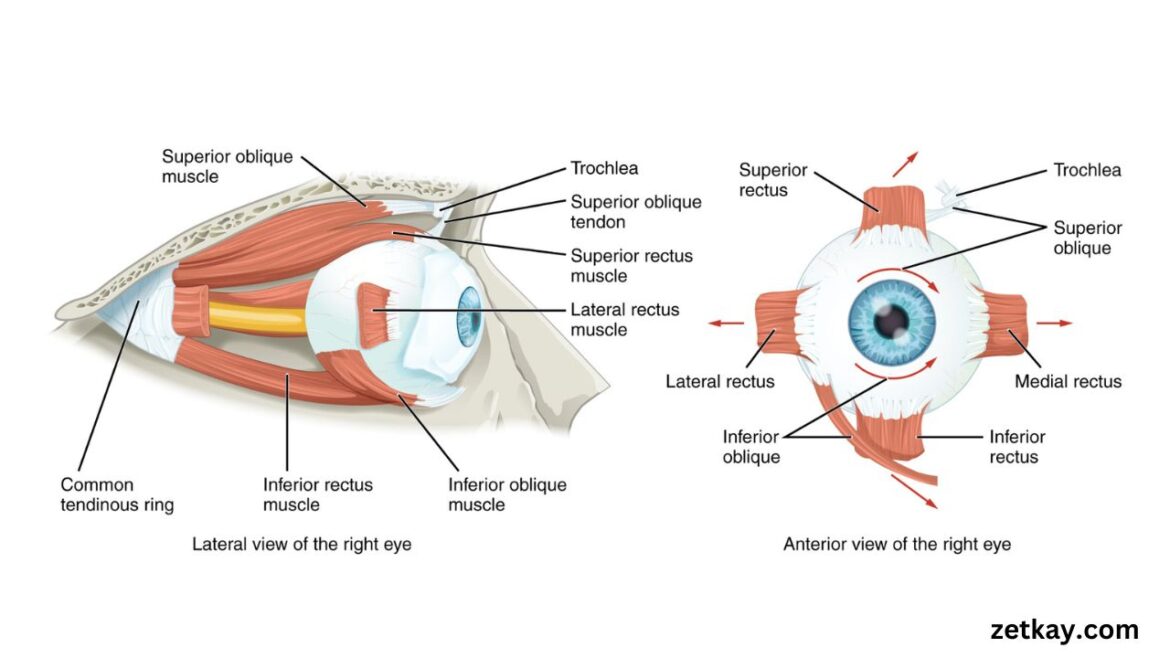Maintaining healthy eye muscles is crucial for clear vision and reducing strain during daily activities. The extraocular muscles play a pivotal role in eye movement, focus, and coordination. This article explores how to relax these muscles effectively while addressing issues related to pain, nerve supply, and movement.
Understanding Extraocular Muscles
Anatomy of Extraocular Muscles
The extraocular muscles are six small skeletal muscles that control the movement of the eyes:

- Superior Rectus – Elevates the eye.
- Inferior Rectus – Depresses the eye.
- Medial Rectus – Moves the eye inward (toward the nose).
- Lateral Rectus – Moves the eye outward (away from the nose).
- Superior Oblique – Rotates the eye inward and downward.
- Inferior Oblique – Rotates the eye outward and upward.
These muscles allow precise and coordinated eye movements, enabling activities like reading, tracking, and focusing.
Nerve Supply to the Eye Muscles
The nerves responsible for extraocular muscle function are:
- Oculomotor Nerve (Cranial Nerve III): Innervates most muscles except the lateral rectus and superior oblique.
- Trochlear Nerve (Cranial Nerve IV): Supplies the superior oblique muscle.
- Abducens Nerve (Cranial Nerve VI): Controls the lateral rectus muscle.
Proper nerve function ensures smooth and coordinated eye movements.
Common Causes of Eye Muscle Tension and Pain
Digital Eye Strain
Prolonged screen time causes overuse of the extraocular muscles, leading to tension and discomfort. Symptoms include headaches, dry eyes, and difficulty focusing.
Sleep Deprivation
Inadequate rest prevents muscle recovery, increasing strain and reducing visual efficiency.
Underlying Medical Conditions
Conditions like strabismus, cranial nerve palsies, or sinus infections can impact muscle health and cause pain or difficulty in movement.
Techniques to Relax Eye Muscles
Eye Exercises
Palming
- Rub your hands together to generate warmth.
- Place your palms gently over your closed eyes for 30 seconds to relax the muscles.
Eye Rolls - Rotate your eyes clockwise and counterclockwise slowly.
- Repeat 5–10 times to improve flexibility and reduce stiffness.
Focus Shifting - Hold your thumb at arm’s length and focus on it.
- Slowly bring it closer, keeping it in focus, then move it away.
- Repeat 10 times to strengthen eye muscles.
Massage and Warm Compress
- Massage
Gently massage the temples and the area around your eyes in circular motions to improve blood flow and relieve tension. - Warm Compress
Apply a warm, damp cloth to closed eyes for 10–15 minutes to soothe tired muscles and promote relaxation.
Maintain Proper Posture
Ensure your screen is at eye level, and keep a comfortable distance while working or reading. Avoid slouching to reduce unnecessary strain on the muscles.
Read More:
5-Minute Jumping Jacks Workout to Boost Your Energy
How to Relieve Sciatica Pain Fast
How Many Eye Muscles Control The Movement Of The Eye
The movement of the human eye is controlled by six extraocular muscles. These muscles work in coordination to allow the eyes to move smoothly in various directions, enabling precise and stable vision.
The Six Extraocular Muscles
- Superior Rectus: Moves the eye upward.
- Inferior Rectus: Moves the eye downward.
- Medial Rectus: Moves the eye inward (toward the nose).
- Lateral Rectus: Moves the eye outward (away from the nose).
- Superior Oblique: Rotates the eye inward and downward.
- Inferior Oblique: Rotates the eye outward and upward.
Functionality
These muscles are controlled by three cranial nerves:
- Oculomotor Nerve (Cranial Nerve III): Controls most of the extraocular muscles except for the lateral rectus and superior oblique.
- Trochlear Nerve (Cranial Nerve IV): Supplies the superior oblique.
- Abducens Nerve (Cranial Nerve VI): Controls the lateral rectus.
This arrangement ensures the eyes can move in all directions, work together for binocular vision, and stay aligned. Proper coordination of these muscles is vital for activities like reading, tracking objects, and maintaining focus on a single point. Disorders affecting these muscles or their nerve supply can lead to problems such as double vision or misalignment.
When to Seek Medical Advice
Persistent Pain or Discomfort
If the pain persists despite relaxation techniques, consult an ophthalmologist to rule out underlying conditions.
Double Vision
Frequent episodes of double vision may indicate issues with muscle coordination or nerve supply.
Strabismus
Misaligned eyes that do not work together require professional evaluation and treatment.
FAQs Related To Eye Muscle
What causes eye muscle pain?
Eye muscle pain can result from digital eye strain, lack of sleep, or conditions like strabismus and cranial nerve palsies.
How can I relax my eye muscles naturally?
Practicing palming, eye rolls, focus-shifting exercises, and applying warm compresses are effective ways to relax eye muscles naturally.
What are the symptoms of strained eye muscles?
Symptoms include headaches, dry eyes, blurred vision, and difficulty focusing on objects.
When should I see a doctor for eye muscle pain?
Seek medical advice if you experience persistent pain, double vision, or symptoms of misalignment like strabismus.
Which of the extrinsic eye muscles passes through the trochlea?
The superior oblique muscle is the extrinsic eye muscle that passes through the trochlea. The trochlea is a pulley-like structure located on the upper medial side of the orbit (eye socket).
How It Works
- The superior oblique muscle originates from the sphenoid bone in the back of the orbit.
- Its tendon passes through the trochlea, changing the direction of its pull.
- After passing through the trochlea, the muscle inserts into the superior and lateral surface of the eyeball.
This arrangement allows the superior oblique muscle to help rotate the eye inward and downward, contributing to complex movements such as looking downward and toward the nose. This function is crucial for coordinated eye motion and depth perception.
Conclusion
Caring for your extraocular muscles is essential for maintaining eye health and reducing discomfort. Regularly practicing relaxation techniques, taking breaks from screens, and maintaining proper posture can significantly alleviate strain. If symptoms persist, consult a healthcare professional to address potential underlying issues. Prioritize eye care to keep your vision sharp and pain-free.
